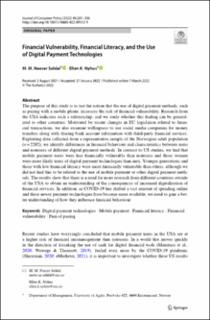| dc.contributor.author | Seldal, Mette Marie Næser | |
| dc.contributor.author | Nyhus, Ellen Katrine | |
| dc.date.accessioned | 2023-04-11T12:25:20Z | |
| dc.date.available | 2023-04-11T12:25:20Z | |
| dc.date.created | 2022-03-08T07:16:58Z | |
| dc.date.issued | 2022 | |
| dc.identifier.citation | Seldal, Mette Marie Næser Nyhus, Ellen Katrine (2022). Financial Vulnerability, Financial Literacy, and the Use of Digital Payment Technologies. Journal of Consumer Policy, 45, 281-306. | en_US |
| dc.identifier.issn | 1573-0700 | |
| dc.identifier.uri | https://hdl.handle.net/11250/3062403 | |
| dc.description.abstract | The purpose of this study is to test the notion that the use of digital payment methods, such as paying with a mobile phone, increases the risk of financial vulnerability. Research from the USA indicates such a relationship, and we study whether this finding can be generalized to other countries. Motivated by recent changes in EU legislation related to financial transactions, we also examine willingness to use social media companies for money transfers along with sharing bank account information with third-party financial services. Exploiting data collected from a representative sample of the Norwegian adult population (n = 2202), we identify differences in financial behaviour and characteristics between users and nonusers of different digital payment methods. In contrast to US studies, we find that mobile payment users were less financially vulnerable than nonusers and those women were more likely users of digital payment technologies than men. Younger generations and those with low financial literacy were more financially vulnerable than others, although we did not find this to be related to the use of mobile payment or other digital payment methods. The results show that there is a need for more research from different countries outside of the USA to obtain an understanding of the consequences of increased digitalization of financial services. In addition, as COVID-19 has shifted a vast amount of spending online and these newer payment technologies have become more available, we need to gain a better understanding of how they influence financial behaviour. | en_US |
| dc.language.iso | eng | en_US |
| dc.publisher | Springer | en_US |
| dc.rights | Navngivelse 4.0 Internasjonal | * |
| dc.rights.uri | http://creativecommons.org/licenses/by/4.0/deed.no | * |
| dc.title | Financial Vulnerability, Financial Literacy, and the Use of Digital Payment Technologies | en_US |
| dc.type | Peer reviewed | en_US |
| dc.type | Journal article | en_US |
| dc.description.version | publishedVersion | en_US |
| dc.rights.holder | © 2022 The Author(s) | en_US |
| dc.subject.nsi | VDP::Samfunnsvitenskap: 200::Økonomi: 210::Samfunnsøkonomi: 212 | en_US |
| dc.source.pagenumber | 281-306 | en_US |
| dc.source.volume | 45 | en_US |
| dc.source.journal | Journal of Consumer Policy | en_US |
| dc.identifier.doi | https://doi.org/10.1007/s10603-022-09512-9 | |
| dc.identifier.cristin | 2008202 | |
| dc.relation.project | Finansmarkedfondet: 290117 | en_US |
| dc.description.localcode | Paid open access | en_US |
| cristin.qualitycode | 1 | |

